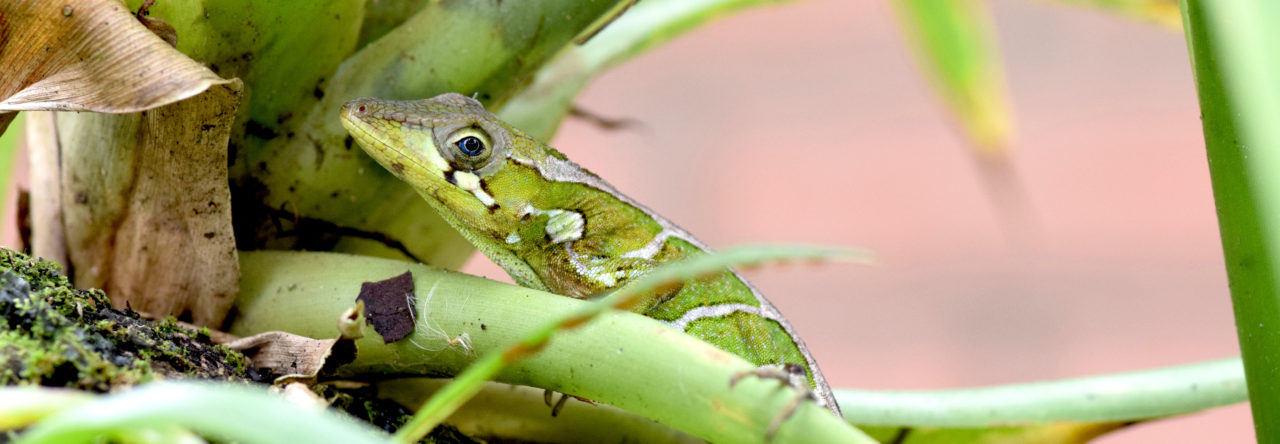 Although devoted to all things Anolis, Anole Annals strives to keep its readers updated on relevant findings concerning other lizards. In that vein, we’ve just learned of a newly completed thesis on lacertid lizards on European islands by Anna Runemark at Lunds University, under the supervision of Erik Svensson. Here’s the English summary of her thesis, from this page, and some remarks from Erik here. Her defense is on May 25th. Good luck, Anna!
Although devoted to all things Anolis, Anole Annals strives to keep its readers updated on relevant findings concerning other lizards. In that vein, we’ve just learned of a newly completed thesis on lacertid lizards on European islands by Anna Runemark at Lunds University, under the supervision of Erik Svensson. Here’s the English summary of her thesis, from this page, and some remarks from Erik here. Her defense is on May 25th. Good luck, Anna!
“Islands are cradles for new biodiversity and provide natural laboratories for the study of population divergence. In my thesis, I investigated the role of different evolutionary processes in the population divergence in the Skyros wall lizard (Podarcis gaigeae), a species where islet populations have strongly diverged morphologies. I used replicate islet populations and their respective most proximate mainland populations to investigate how divergence has proceeded following the isolation of the islets. First, I combined bathymetric maps with sea level curves and molecular inferences based on Bayesian statistics to investigate the biogeographical history of populations. I found that islet populations have become isolated by vicariance following sea level rises during the last thousands of years, and no significant gene flow between populations. To investigate which processes are affecting population divergence, I studied patterns of divergence in coding genetic variation, traits assumed to be under simple Mendelian inheritance, morphological and behavioral traits. A clear pattern of parallel adaptive divergence in the islet environment emerged for traits mainly subjected to natural selection. Islet lizards were larger, greener and less prone to escape. Islet lizards were also less cryptic in their environments than were mainland lizards. Moreover, between-population variation in size and color was larger for islet- than for mainland populations. These patterns are indicative of a predation release. I also found that islet lizards have relatively wider and differently shaped heads as well as a stronger bite force in relation to mainland populations. Data on available food and realized diet suggest that these changes are adaptations to harder island diet. Together these data suggest that predation release and selection for a diet change have interacted and jointly driven the evolution of larger body sizes on islands.
No general pattern of parallel divergence was found for traits subjected primarily to sexual selection. Instead, divergence in throat color morph frequency and sex pheromone composition were significantly correlated with neutral genetic divergence. This indicates that stochastic processes such as genetic drift have contributed to divergence of these traits. I also investigated if mate preferences for pheromones, throat color and body size could be driving population divergence. I found no population differences in preferences for throat color and body size, suggesting that mate choice does not drive divergence in these characters. Islet populations did, however, prefer scent from islet lizards, whereas mainland lizards were less discriminatory. This implies that there could be some mate discrimination against mainland lizards that disperse to islets.
We also examined the effect of low population sizes and genetic drift on the Major Histocompatibility Complex (MHC), immune genes which are subjected to stabilizing natural and sexual selection. I found that MHC diversity was significantly correlated with neutral genetic divergence, suggesting an influence of genetic drift. I did, however, also find indications of selection counteracting genetic drift and preserving between-allele diversity in small populations. Finally, I investigated if there were any inbreeding effects due to small population sizes and genetic drift, and whether inbreeding effects differ between sexually- and naturally selected traits. I did not find any inbreeding effects on the naturally selected traits. In contrast, the size of a sexual signaling trait, ventral blue patches expressed only in male lizards, was significantly correlated with heterozygosity in mainland populations, but not in islet populations in spite of their lower heterozygosity levels. This suggests that sexually selected traits may be more sensitive to inbreeding, and that purging of deleterious mutations affecting the blue patches negatively may have occurred in islet populations.
- Evolution in Real Time on Lizard Island - March 23, 2025
- Spider Snags Adult Anolis osa - March 22, 2025
- An Homage to the Green Anoles of New Orleans - March 21, 2025


Pierre Legreneur
This thesis looks really fascinating. I will wish to really get a copy if possible!
Anna Runemark
First, thanks for posting my thesis here, that is very kind.
If anyone wishes to have a copy, please write me an email at Anna.Runemark@biol.lu.se and I would be more than happy to either send a physical copy or pdf-version.
Andreas Kanas
I am an Agronomist from Skyros and I would like to get a copy of this thesis if posible
Jonathan Losos
The author’s email is in the comment above yours. I’m sure she would be happy to help.